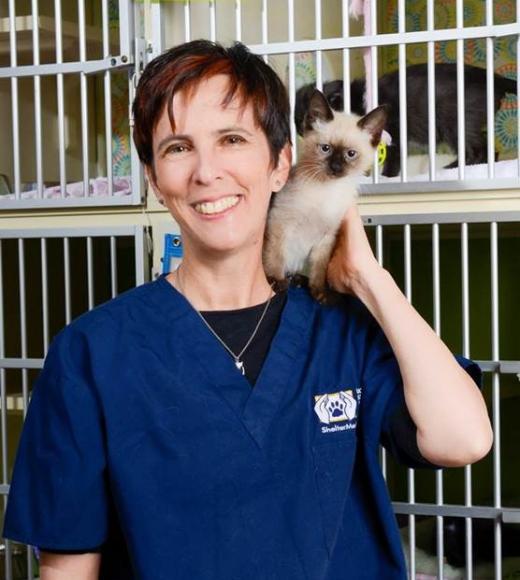
Dr. Hurley began her career as an animal control officer in 1989. After graduation from the UC Davis School of Veterinary Medicine in 1999, she worked as a shelter veterinarian for two years before returning to UC Davis to become the first person in the world to undertake a residency in shelter medicine. Following completion of the residency, Kate remained at UC Davis to become the director of the Koret Shelter Medicine Program. Her interests include the welfare of confined dogs and cats; humane and effective strategies to manage community cats, humane and effective strategies for workflow management and work life balance for shelter leaders; and one-eyed orange cats and unusually short dogs. Her proudest achievements including co-authoring “The Association of Shelter Veterinarians’ Guidelines for Standards of Care in Animal Shelters”, co-editing the textbook “Infectious Disease Management in Animal Shelters” and co-creating the Million Cat Challenge, the world’s largest feline life saving campaign. Kate loves shelter work because it has the potential to improve the lives of so many animals and the people who care for them.
Selected Publications
- Wagner, D.C., Hurley, K.F., Stavisky, J.H. (2018). “Shelter housing for cats: Principles of design for health, welfare and rehoming.” Journal of Feline Medicine and Surgery 20(7), 635-642
- Wagner, D.C., Hurley, K.F., Stavisky, J.H. (2018). “Shelter housing for cats: Practical aspects of design and construction, and adaptation of existing accommodation.” Journal of Feline Medicine and Surgery 20(7), 643-652
- Wagner, D.C., Kass, P.H., Hurley, K.F. (2018). “Cage size, movement in and out of housing during daily care, and other environmental and population health risk factors for feline upper respiratory disease in nine North American animal shelters.” PLoS ONE 13(1): e0190140.
- Karsten, C.L., Wagner, D.C., Kass, P.H., Hurley, K.F. (2017). “An observational study of the relationship between Capacity for Care as an animal shelter management model and cat health, adoption and death in three animal shelters.” The Veterinary Journal 227: 15-22.
- Scherk, M. A., R. B. Ford, Gaskell, R.M. Hartmann, K., Hurley, K.F., Lappin, M.R., Levy, J.K., Little, S.E., Nordone, S.K., Sparkes, A.H. (2013). “2013 AAFP Feline Vaccination Advisory Panel Report.” J Feline Med Surg 15(9): 785-808.
- Kamiya, C., D. C. Wagner, et al. (2013). “The effect of cage size on the expression of normal behaviors in shelter cats.” Annual House Officer Seminar Day, Davis, CA.
- Tanaka, A., D. C. Wagner, Hurley, K.F. (2012). “Associations among weight loss, stress, and upper respiratory tract infection in shelter cats.” J Am Vet Med Assoc 240(5): 570-576.
- Newbury, S. and K. F. Hurley (2012). Population Management. Shelter Medicine for Veterinarians and Staff. L. Miller and S. Zawistowski. Ames, Iowa, Blackwell Publishing: 93-114.
- Hurley, K. F. and P. A. Pesavento (2012). Disease recognition and diagnostic testing. Shelter Medicine for Veterinarians and Staff. L. Miller and S. Zawistowski. Ames, Iowa, Blackwell Publishing.
- Welborn, L. V., J. G. DeVries, Ford, R., Franklin, R.T., Hurley, K.F., McClure, K.D., Paul, M.A. , Schultz, R.D. (2011). “2011 AAHA canine vaccination guidelines.” J Am Anim Hosp Assoc 47(5): 1-42.
- Kruger, E. F., B. A. Byrne, Pesavento, P., Hurley, K.F., Lindsay, L.L., Sykes, J.E., (2010). “Relationship between clinical manifestations and pulsed-field gel profiles of Streptococcus canis isolates from dogs and cats.” Vet Microbiol.
- Newbury, S.P., Blinn, M.K., Bushby, P.A., Cox, C.B., Dinnage, J.D., Griffin, B., Hurley, K.F., Isaza, N., Jones, W., Miller, L., O’Quin, J., Patronek, G.J., Smith-Blackmore, M., Spindel, M. (2010). “Guidelines for Standards of Care in Animal Shelters”, The Association of Shelter Veterinarians.
- Miller, L. and Hurley, K.F., (2009) “Infectious disease management in animal shelters” Wiley-Blackwell Publishing, Ames, Iowa., 400 pages.
- Drazenovich, TL, Fascetti AJ, Westermeyer HD, Sykes JE, Bannasch MJ, Kass, PH, Hurley, KF, Maggs, DJ. (2009) “Effects of dietary lysine supplementation on upper respiratory and ocular disease and detection of infectious organisms in cats within an animal shelter.” Am J Vet Res 70(11): 1391-1400.
- Hurley, K. F. and C. J. Baldwin (2008). “Developing Infectious Disease Policies and Procedures in an Animal Shelter”. Maddie’s Infection Control Manual for Animal Shelters. C. A. Petersen, G. Dvorak and A. R. Spickler. Des Moines, Iowa, Colorfx: 66-79.
- Pesavento, P. A., Hurley K.F., et al. (2008). “A clonal outbreak of acute fatal hemorrhagic pneumonia in intensively housed (shelter) dogs caused by Streptococcus equi subsp. zooepidemicus.” Vet Pathol 45(1): 51-3.
- Timmins, R. P., Hurley, K.F., K. D. Cliff, et al. (2007). “Enhancing quality of life for dogs and cats in confined situations.” Animal Welfare16(Supplement 1): 83-87.
- Pesavento, P. A., Hurley, K.F., Bannasch, M.J. et al. (2007). “Fatal Streptococcus canis infections in intensively housed shelter cats.” Vet Pathol 44(2): 218-21.
- Hurley, K. F. Feline infectious disease control in shelters. Vet Clin North Am Small Anim Pract 2005; 35(1): 21-37.
- Hurley K.F., Pesavento PA, Pedersen NC, Poland AM, Wilson E, Foley JE. An outbreak of virulent systemic feline calicivirus disease. J Am Vet Med Assoc. Jan 15 2004;224(2):241-249.
- Hurley K.F., Sykes JE. Update on feline calicivirus: new trends. Vet Clin North Am Small Anim Pract. Jul 2003;33(4):759-772.
- Hurley K.F. Implementing a population health plan in an animal shelter: goal setting, data collection and monitoring, and policy development. In: Miller L, Zawistowski S, eds. Shelter Medicine for Veterinarians and Staff. Ames, Iowa: Blackwell Publishing; 2004:211-235.
